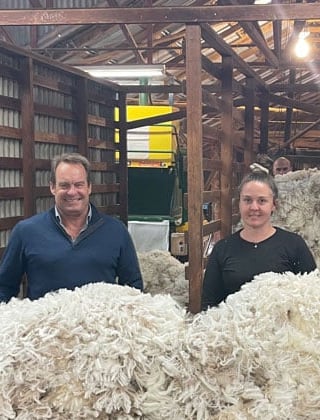Welcome to Australian Wool Innovation, a hub for the woolgrowers of Australia.
Not a woolgrower? Looking for information about wool products, wool care or wool processing?
The Woolmark Company is the global authority on wool. Visit Woolmark.com instead.
New biological wool harvesting research

AWI is funding research into a new opportunity for biological defleecing using a natural protein found in corn that generates a weakened zone at the base of the wool fibre but, importantly, enables the fleece to stay on the sheep without a net until the wool can be removed.
AWI is funding research into a new opportunity for biological defleecing using a natural protein found in corn that generates a weakened zone at the base of the wool fibre but, importantly, enables the fleece to stay on the sheep without a net until the wool can be removed.
Many woolgrowers will probably have heard of Bioclip®, a biological defleecing process developed by CSIRO and made available in the 1990s, which allowed wool to be harvested without the use of a mechanical handpiece. To harvest the wool, sheep are given a single vaccination of Epidermal Growth Factor (EGF) that causes a break to occur in the wool fibres. Over the sheep and fleece is placed a net into which the fleece is shed about one week after the sheep is injected.
It works, but there was little take-up by woolgrowers, mainly because the putting on and removal of the nets from the sheep made it a labour-intensive process.
However, there is potentially a new opportunity for biological wool harvesting based on a new protein, the zein class of protein found in corn, that could enable harvesting without the need for nets.
“This protein was shown by the University of Adelaide to cause a weakening of the staple of most of the fibres, to such an extent that a mechanical removal device will break the fibre and remove the fleece without the need for cutting equipment,” said Dr Jane Littlejohn, AWI General Manager, Research.
“The important thing about this proved concept was that this treatment allows the fleece to stay on the sheep without a net – and that's revolutionary, and potentially could be a real labour-saving option for woolgrowers compared to Bioclip.”
Compared to traditional shearing, biological wool harvesting also eliminates second-cuts and skin pieces and can reduce variability in wool fibre length.
A small trial has already been undertaken by the University of Adelaide in which the fleece did not fall off in the paddock under normal grazing conditions for up to ten weeks after the protein was administered. This trial has provided AWI with the confidence to proceed to larger scale trials.
“During these new trials, the University of Adelaide will need to determine how best to administer the treatment and the most appropriate dosage,” Jane said.
“The University also must develop some sort of machine or method to break the fibre and harvest the wool in the most efficient and labour-saving way.”
The project will run over several years to check whether there are any negative impacts on wool growth and quality as well as animal growth and health.
“It’s important that the fleece stays on for long enough for the staple to grow a few millimetres to protect the sheep from sunburn and hypothermia – and we certainly want the next growing cycle to be unaffected by any product that is being given to the sheep,” Jane said.
“Although this is a high-risk project, it has already shown a lot of promise and it is being fast-tracked.”
The project continues years of collaboration with the University of Adelaide on this type of research. It is an example of the multi-pronged approach that AWI is now taking to make wool harvesting easier and more cost-effective for woolgrowers and the industry.
This article appeared in the September 2022 edition of AWI’s Beyond the Bale magazine. Reproduction of the article is encouraged.















